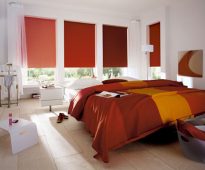 Types of components for roller blinds on plastic windows
Types of components for roller blinds on plastic windows
Description and types of organza tulle: DIY hand-made curtains
Tulle organza is a light, thin, almost transparent fabric made from polyester, silk and cotton. Such "day curtains" perfectly hide from prying eyes those who are inside the room, but provide a good overview. A very cheap or truly “royal” product for a window can be bought in a store or sewn with one's own hand.
Transparent organza curtains are especially in demand because they are in harmony with any style.
They gently scatter the daylight and fill the room with comfort.
Content
- 1 Description of organza tulle. Appearance and examples of curtains
- 2 Description, models and varieties of organza. The structure of the fabric and its colors
- 3 Comparative characteristics of the veil and organza, their main differences
- 4 The right choice of fabric, cutting and tailoring organza curtains do it yourself
- 5 Examples and photos of organza curtains in the interior of the apartment
- 6 Conclusion
- 7 VIDEO: Organza for curtains. What is different from the veil.
- 8 50 photos of organza tulle in modern interiors:
Description of organza tulle. Appearance and examples of curtains
Tulle, originally invented in France, is now being produced by many countries, including Russia. On sale there are high-quality German tulle and inexpensive Turkish. Transparent draperies are made from both natural and synthetic, mixed fibers, they are characterized by low crushability and low stretchability.
Organza is a light and airy fabric, which is made using a special technology of twisting fibers.
Organza is light and thin, transparent and durable fabric used to create curtains, ballet tutus, and other draperies. Curtain products made of it are hung on clips, tape, grommets, decorated with colored or single-color embroidery, and various printed drawings.
Thanks to this method of fabrication, organza curtains are practical and aesthetic at the same time.
"In trend" today is the combination of the finest organza with dense heavy materials. The combination of two or four different shades of the same color within the same window looks interesting - in order to achieve the maximum effect, they are made in sharp contrast or at a distance of at least three tones on the color wheel.
Organza consists of natural or synthetic fibers, is weightless and durable, transmits and disperses the sun's rays, is easy to maintain.
Organza is combined with any material.
Council In many “lightweight” interior styles, tulle is used as an independent window drapery. This option is optimal for windows facing the north, north-west side, but is not suitable for the south, south-east.
The high level of strength due to the special technique of twisting threads in the manufacture of cloth.
Description, models and varieties of organza. The structure of the fabric and its colors
In color, the “classical” organza is most often produced in white or cream, but there are also other variants - pink, blue, green, black, beige, and violet. Curtain models are also offered all kinds of:
Today, designers are widely using various styles to decorate windows.
At the request of textiles on the window can be as a soft and organic addition to the overall concept of the interior, and a luxurious color or textured accent of the room.
- in the form of several direct canvases contrasting among themselves;
- single transparent drapery with embroidery, bright print;
- smooth, shiny fabric with many carefully smoothed folds;
- discreet matte curtain;
- items decorated with metal thread;
- reaped version, decorated with sequins;
- printed or perforated fabric;
- drapery, laid horizontal folds, secured with special clips.
In modern interiors, curtains are most often called curtains that are sewn from light and delicate fabrics - organza, tulle and veil.
Multi-layer translucent organza curtains decorate and visually enlarge a small window.
In addition to organza in the production of curtains used tulle chiffon - matte textured, "flowing" fabric. Often it is decorated with embroidery, printed pattern. Such a product is worth a little, drapes well, and disperses daylight well.
Fabrics made from natural fibers of a patterned, checkered or cellular structure that are well breathable may be an ideal option for curtains.
Tip: when the bottom edges of the curtain are bent, it is permissible to weight them - for this, decorative tape, cord, figurines or tassels with clips are used.
Comparative characteristics of the veil and organza, their main differences
Tulle veil has different reviews: some like this soft material, others do not. Tulle, an eternal classic made of a polyester veil, does not fade for a long time even when placed on the sunny side, well passes light, creating a feeling of lightness and weightlessness of the entire interior.
Curtains of such material have high light and air permeability.
The original and luxurious tulle with royal designs will not only make the street light a little softer, but will give the room a luxurious look. A clear intricate pattern is applied to the surface of the product with resistant paints. Different types of tulle veil made in Germany are of excellent quality - they are all soft, very thin, transparent.
Here gold or silver plating is often used.
The right choice of fabric, cutting and tailoring organza curtains do it yourself
To the question, what is the best organza or tulle from a veil, there is no definite answer. Tailoring the most original organza curtains with your own hands is not difficult if there is an interesting idea, high-quality material, and sometimes also a good pattern. For high-quality cutting, you need a large, flat surface, scissors, for sewing you will need threads to match the fabric, a sewing machine.
Classic style living room with translucent organza curtains.
The color of the curtain is chosen under the existing interior style. For the kitchen, short options are preferable, in the living room - elongated, for the bedroom - lush, made in soothing colors. When calculating the amount of fabric, it is important to consider the height from the floor to the eaves, the width of the window: to create a fluffy curtain in the fold, you need at least three meters of fabric with a meter window, six meters for a two-meter, etc.
Fashion trends involve the use of new types of organza when decorating windows.
The material before purchase must be meticulously examined - any defects in the form of puffs, fibers, on the finished product will be very noticeable, to disguise them is unlikely to work. The easiest way to get the top is with a curtain tape, and the bottom, especially if the curtain is supposed to be in the shape of an arch, with an oblique inlay.
It is practical to use them in the kitchen to create the effect of lightness and to make a practical short length to the window sill.
Council The tighter and darker the curtain room, the brighter, lighter, shiny fabric is used for it. Even the matte curtains of cold and dark shades — black and gray, blue-green, dark purple, and burgundy — will suit tall rooms with several windows facing south.
Curtains floor-length or softly draping on the floor will never go out of fashion.
Examples and photos of organza curtains in the interior of the apartment
Curtains made of organza are often decorated with ornaments - geometric, floral, plot. In luxurious interiors such as Baroque, Empire, Art Deco, crystals, sequins, glass bead embroidery, flowers or bows made of satin ribbons are used.
This type of fabric has iridescent texture and silky shine.
For those who love bright light curtains fit light and bright organza.
Country-rooms are decorated with checkered draperies, the classics are decorated with lambrequins and pickups, including metal ones. Oriental interiors abound in variegated colors, elegantly folded folds - there are a lot of fabrics here, zoning of large rooms is also done with its help.
Using this color in the window decoration helps to achieve the effect of lightness and harmony.
For children's rooms, often used colored textile stripes in the form of fabulous animals, heroes of their favorite cartoons. Textiles for kitchen premises, partially glazed balconies are chosen to be smooth, not easily soiled, especially when the windows overlook a busy highway.
White organza curtains have the ability to visually enlarge the space.
Tulle from tulle is considered a kind of veil on which it is easy to embroider or knit various patterns with your own hands. This material is completely uniform, matte or shiny. Fatin is produced hard, medium or in the form of a "European grid".
Designers often use this shade in the interior as a stylistic accent.
Conclusion
Different types of tulle are made of chiffon, organza, veil, tulle, some other types of transparent fabrics. Colored or snow-white curtains can be combined with any thick curtains, creating unique beauty interiors. The most interesting options for window draperies are sewn at home or under the order in the nearest sewing workshop.
When creating a modern style indoors, designers use fashion trends and experiment with trim, color and textures.
When designing the curtains, it is necessary to take into account all the details.
VIDEO: Organza for curtains. What is different from the veil.
50 photos of organza tulle in modern interiors:
 Types of components for roller blinds on plastic windows
Types of components for roller blinds on plastic windows
 How to measure roller blinds on plastic windows
How to measure roller blinds on plastic windows
 Manufacturers and suppliers of roller blinds
Manufacturers and suppliers of roller blinds






